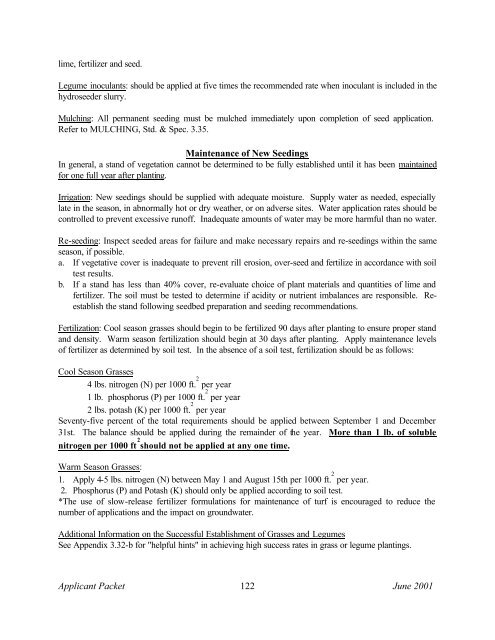APPLICANT PACKET - Virginia Department of Conservation and ...
APPLICANT PACKET - Virginia Department of Conservation and ...
APPLICANT PACKET - Virginia Department of Conservation and ...
You also want an ePaper? Increase the reach of your titles
YUMPU automatically turns print PDFs into web optimized ePapers that Google loves.
lime, fertilizer <strong>and</strong> seed.<br />
Legume inoculants: should be applied at five times the recommended rate when inoculant is included in the<br />
hydroseeder slurry.<br />
Mulching: All permanent seeding must be mulched immediately upon completion <strong>of</strong> seed application.<br />
Refer to MULCHING, Std. & Spec. 3.35.<br />
Maintenance <strong>of</strong> New Seedings<br />
In general, a st<strong>and</strong> <strong>of</strong> vegetation cannot be determined to be fully established until it has been maintained<br />
for one full year after planting.<br />
Irrigation: New seedings should be supplied with adequate moisture. Supply water as needed, especially<br />
late in the season, in abnormally hot or dry weather, or on adverse sites. Water application rates should be<br />
controlled to prevent excessive run<strong>of</strong>f. Inadequate amounts <strong>of</strong> water may be more harmful than no water.<br />
Re-seeding: Inspect seeded areas for failure <strong>and</strong> make necessary repairs <strong>and</strong> re-seedings within the same<br />
season, if possible.<br />
a. If vegetative cover is inadequate to prevent rill erosion, over-seed <strong>and</strong> fertilize in accordance with soil<br />
test results.<br />
b. If a st<strong>and</strong> has less than 40% cover, re-evaluate choice <strong>of</strong> plant materials <strong>and</strong> quantities <strong>of</strong> lime <strong>and</strong><br />
fertilizer. The soil must be tested to determine if acidity or nutrient imbalances are responsible. Reestablish<br />
the st<strong>and</strong> following seedbed preparation <strong>and</strong> seeding recommendations.<br />
Fertilization: Cool season grasses should begin to be fertilized 90 days after planting to ensure proper st<strong>and</strong><br />
<strong>and</strong> density. Warm season fertilization should begin at 30 days after planting. Apply maintenance levels<br />
<strong>of</strong> fertilizer as determined by soil test. In the absence <strong>of</strong> a soil test, fertilization should be as follows:<br />
Cool Season Grasses<br />
4 lbs. nitrogen (N) per 1000 ft. 2<br />
per year<br />
1 lb. phosphorus (P) per 1000 ft. 2<br />
per year<br />
2 lbs. potash (K) per 1000 ft. 2<br />
per year<br />
Seventy-five percent <strong>of</strong> the total requirements should be applied between September 1 <strong>and</strong> December<br />
31st. The balance should be applied during the remainder <strong>of</strong> the year. More than 1 lb. <strong>of</strong> soluble<br />
nitrogen per 1000 ft 2<br />
should not be applied at any one time.<br />
Warm Season Grasses:<br />
1. Apply 4-5 lbs. nitrogen (N) between May 1 <strong>and</strong> August 15th per 1000 ft. 2<br />
per year.<br />
2. Phosphorus (P) <strong>and</strong> Potash (K) should only be applied according to soil test.<br />
*The use <strong>of</strong> slow-release fertilizer formulations for maintenance <strong>of</strong> turf is encouraged to reduce the<br />
number <strong>of</strong> applications <strong>and</strong> the impact on groundwater.<br />
Additional Information on the Successful Establishment <strong>of</strong> Grasses <strong>and</strong> Legumes<br />
See Appendix 3.32-b for "helpful hints" in achieving high success rates in grass or legume plantings.<br />
Applicant Packet 122<br />
June 2001
















